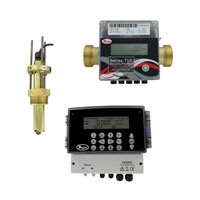Flow Technologies: Out With the Old, In With the New
Flow Technologies: Out With the Old, In With the New
As technology advances and new ways to solve old problems are discovered, consumers are left to decide whether existing technology suffices for their specific needs or if they need to pursue new, higher cost technology alternatives. This is very much the case when considering flow instrumentation where moving parts, such as turbines and paddles, are being replaced with non-moving part technologies, such as: ultrasonic, thermal, or electromagnetic sensors. But how do you decide which of these products to select for your flow application? Below is a list of items to take into consideration when deciding between mechanical or non-mechanical technology flowmeters.

Media
The first item to consider when faced with utilizing a mechanical or non-mechanical technology flowmeter is the quality of the process fluid. When faced with an application which boasts process fluid laden with particulates, a non-mechanical flowmeter (such as thermal or electromagnetic) is recommended. Mechanical flowmeters come in contact with the process flow and utilize moving parts to measure velocity. Since these parts are exposed to the flow, they can be adversely affected by any debris or particles. This not only affects the flow reading, but can also damage or break the unit. Non-mechanical technologies feature no moving parts and generally work well with particulates present in the fluid, while recognizing any other limitation that specific technology may have.
Accuracy
Another important consideration of the application is the required accuracy. Electromagnetic flowmeters can read up to a 0.1% accuracy, while mechanical flowmeters can offer a 1% accuracy. In addition, mechanical flowmeters tend not to operate well in low velocity applications (because of the force necessary to move the impeller or paddle) or in high velocity applications (where vibrations and constant movement increase wear and adversely affect accuracy).
Maintenance
It is also necessary to regard the amount of maintenance required by different technologies. Even in applications with clean water, the impeller or turbines of mechanical technologies will be worn by the flow of the application. In the long term, it is important to schedule recurring maintenance and ensure that the unit’s moving parts are regularly inspected.
Cost
Once the media, accuracy, and maintenance requirements of the application are understood, the cost of the product technologies can be compared. If the media and accuracy are acceptable and long-term maintenance is not an issue, a mechanical meter may be a good selection. In cases where accuracy is critical, the flow media is dirty, or constant maintenance is not acceptable, a non-mechanical flowmeter should be considered. Generally, mechanical type flowmeters are a lower cost when compared to non-mechanical flowmeter types.
It is important to the success of any fluid measurement to have a keen understanding of the technology to be used to measure the application fluid. When faced with picking between traditional or new flow technologies, there are a slew of considerations, other than price, that need to be taken into account.
